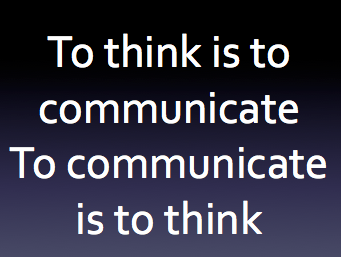Some conceptual issues in discursive research:
 Discursive research – a research approach that views human communication as a topic in its own right as opposed to treating it as a mere window to something else e.g one’s thoughts, concepts or mental schemes
Discursive research – a research approach that views human communication as a topic in its own right as opposed to treating it as a mere window to something else e.g one’s thoughts, concepts or mental schemes- Thinking – in a strong discursive research, thinking is defined as an activity of communicating with oneself
- Discourse – a specific type of communicating; a product of collective human actions
- Mathematical thinking = mathematics
- Mathematics is a type of discourse
- Mathematical discourse can be characterized through its keywords, visual mediators, routines, and endorsed narratives
- Examples of keywords in mathematical discourse: “four”, “rectangles”, “set”, “function” which are used in mathematical ways
- Examples of visual mediators: numeral, algebraic symbols, graphs, tables
- Routines – patterned ways in which mathematical task are being performed
- Endorsed narratives – theorems, definitions, computational rules (These are endorsed by the competent participants of the mathematical community, i.e., mathematicians)
- Mathematics learning is tantamount to becoming a member of a mathematical community
- Development refers to historical and ontogenetic change in ways of communicating
- Learning refers to a particular type of ontogenetic discourse and therefore is to be understood as subordinate to development and not complementary to it.
- Learning involves mainly reproductive (as opposed to productive or creative) change in discourse. It is a change aimed at bringing the discourse of the learner closer to a historically established form of discourse. In sum, learning extends the community of discourse rather than changing the discourse itself.
- Object-level development is one that expresses itself in the expansion of what is known about the already existing universe of mathematical objects. In strong discursive terms, this is attained by exploring the objects so as to be able to formulate and endorse new narratives about them. Object-level growth, therefore, is mainly accumulative. A good example of this kind of development is one that results from investigating new families of functions, carried out after the object called “function” has been defined and some basic narratives about it have been endorsed.
- Meta-level developments originate in reflection about the existing discourse in its entirety (as opposed to reflection on its objects), and result in changes that are not a matter of a simple accretion. The new discourse is incommensurable with the preceding one: an expansion of the discourse and the increase in its complexity are accompanied, if not outright conditioned, by a change of meta-discursive rules.
- In meta-level development, even the old discourse will be, from now, subject to these new rules. In most cases, such change is necessitated by an introduction of new mathematical objects. Thus, for example, almost any type of number, the rational, the negative, the irrational or the complex, when first introduced, does not seem acceptable unless some of the previously endorsed narratives can be dispensed with.
- Mathematical object is defined as a mathematical signifier together with its realization tree.
- Signifier is any mark or sound that can be used in communication and is supposed to direct us to something else. This “something else” is a physical object, usually also a signifier, that counts as a realization of the original signifier.
- The realization tree is a hierarchically organized set of all the realizations of the given signifier, together with the realizations of these realizations, as well as the realizations of these latter realizations, and so forth.
Want to know more about discursive research in mathematics education? Read Thinking as Communicating (Learning in Doing: Social, Cognitive and Computational Perspectives) by Anna Sfard
